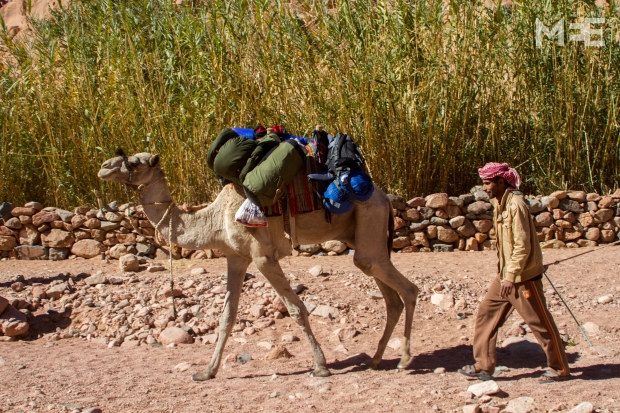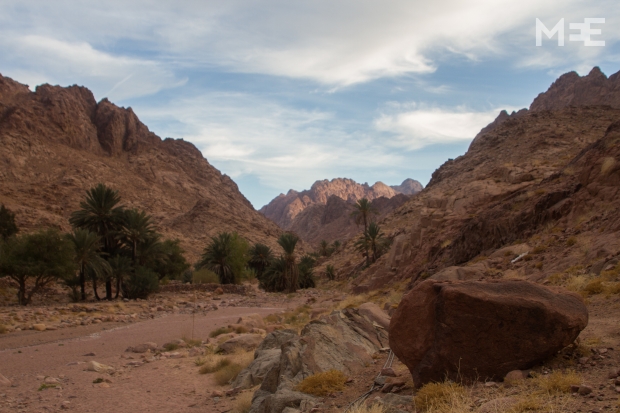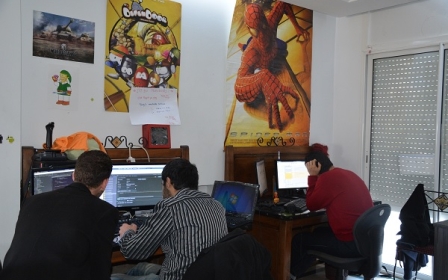Bedouins from South Sinai return to their origins

SAINT KATHERINE, Sinai - In the fifth century, Roman Emperor, Justinian the First sent a group of men from the northern part of what is known today as Romania to the Monastery of Saint Katherine, in the Sinai Peninsula, to build a church and a defensive wall. The platoon, somewhere between 20 and 40 men in total, were ordered to remain there and protect the holy site from the barbarian tribes. Today, the descendants of those men constitute the Jabaliya tribe and continue to protect the monastery, despite having converted to Islam in the sixth century.
Jabaliya translates from Arabic to "from the mountain", as it is in the mountains of the southern third of the peninsula where this tribe lives. Its capital, the town of Saint Katherine, built close to the monastery, lays roughly 1,500 metres over sea level. It is not an easy land: mountains are arid, temperatures are extreme and resources are minimal.
But they acclimated to the land. They learned how to optimise the few resources available by learning the terrain by the inch. They also greatly revered nature. A familiar Bedouin saying warns, “If you kill a tree, you kill a soul." They took advantage of the little rain that falls each year, and began planting trees and building orchards. These orchards are small plots of land that are walled to keep animals out. They also became shepherds, driving their animals to areas where bits of green appear amid the brown sands and stones.
“My grandfather used to spend the summer in his orchard. He used to take care of his fruit, he would harvest it and dry it. At the end of the summer, together with other tribesmen and even with people from other tribes, they walked to Cairo or Suez with their camels to sell or trade their products,” recalls Nasser, a young guide from the Jabaliya tribe. From Cairo, Bedouin would return with sugar cane. Then they would light fires on the tops of the mountains, the sign awaited by the tribes in Saudi Arabia, in the other end of the Gulf of Aqaba, to go and bring tea and spices for trade. It was a simple life.
But everything began to change when the state of Israel was founded in 1948. Back then, with the new border, the lands of some Bedouin tribes (there are up to 12 in the peninsula) were divided. Smuggling replaced trading. Bedouins were first row witnesses to a war which was not theirs. Then from 1967 to 1982, they were forced to live under the rule of Israel, occupier of the peninsula after the Six Day War.
But it was different for the Jabaliya. The inner mountains, around Saint Katherine, were declared a protected area and the people of the tribe began working as guides for tourists, who came by the thousands to climb Mount Sinai to see the sunrise from its top and visit the monastery. On a good season, up to a thousand visitors would make the trip from the coastal resorts daily.
They were good times, but Bedouins started to lose their identity. “Tourists made people forget who they were. They worked for a daily salary, not looking to the future,” says Mohamed Kheir, from the South Sinai Community Foundation. In the 1980s, the younger Jabaliya tribesmen started to ignore their orchards and livestock, looking only to the easy money brought by visitors.
Between 2004 and 2006, a series of bomb attacks shook the coast of the Red Sea. They were planned by Arabs, but some Bedouins were also said to be involved. A hotel just by the border with Israel, in Taba, was hit in 2004, together with two beach camps on the popular site of Ras Sheetan, leaving 34 people dead. In 2005, the resort city of Sharm al-Sheikh was hit by a number of bombs, killing 88. A year later in Dahab, the other main tourist town along the coast, 23 others died in yet another bombing. Since then, tourism began to decrease, especially with Israelis, who still had the feeling that the Red Sea coast belonged to them. “We always say that this is the best place of Israel,” said Sharon, an Israeli woman on a family vacation in an almost empty beach camp near the town of Nuweiba back in 2011.
Five years later, the Egyptian people's uprising against long-time ruler Hosni Mubarak and his regime emptied the area of foreigners, fearing that the continuous clashes in Cairo and other major Egyptian cities applied also to the south of Sinai. In addition, the increasing unrest in the northern part of the peninsula, around the border with Gaza, did not help strengthen the image of noble and hospitable people that the Bedouins have forged over the centuries.
Local guides among the Jabaliya now have few visitors to guide, drivers have few to drive and shopkeepers selling souvenirs have almost nobody to sell their products to. Young Bedouins and the elderly, without a proper education, have difficulty finding jobs and stay home. They gather to drink their exquisite Bedouin tea and smoke water pipes, or they just leave for Cairo seeking a better future.
Almost daily, during the spring and summer time, Hussein takes the path that starts behind the last houses of Saint Katherine. It gains altitude quickly, but once in the pass, it becomes a charming walk through the valley, between sinuous rocks and occasional water springs. In around an hours time, Hussein reaches his orchard.
“My grandfather bought it a hundred years ago, I believe. This orchard is around 300 years old. My father also worked it, but when he stopped, it was abandoned for 20 years. There was work in tourism. Now, I came back because it is important for the household," says Hussein, after collecting some pomegranates. He also has olive trees, apricots, vineyards and pears.
Through the South Sinai Community Foundation, Mohamed Kheir encourages people to go back to the orchards. They help to build external walls, wells and small damns to store water from the rain or the occaisional winter snow. Last year, Mohamed says, a third of the families from Saint Katherine went back to cultivate the over 400 orchards in the valleys of the area. “With an orchard, the Bedouin have something, a piece of land. Land has always been something important for us,” says Mohamed, who emphasises the high quality of the products, completely organic.
But gardens are not enough for modern life. Going back to the origins of the culture is important, but tourism is as well. That's why Bedouins want to attract tourism again, and not only through the one-day trips to the monastery. Taking advantage of the ancient paths that lead to the orchards and connect the valleys, they are now pushing trekking and ecotourism trips. This would allow visitors to spend more time and gain a better knowledge of the area. Bedouins in Saint Katherine are searching for quality, rather than quantity tourism.
“You get everything, from big, rounded peaks to mountains that look like the Matterhorn. I think they're the most spectacular mountains in the Middle East,” says Ben Hoffler an English member of the Royal Geographic Society in London, and author of the first trekking guide of the peninsula, who has been in and out Saint Katherine for more than six years and helps the Bedouin community develop trekking routes and strategies.
Despite the increasing unrest fueled by Islamist fighters in North Sinai, local Bedouins from the Jabaliya and other tribes, recently organised a couple of treks in the mountains around Saint Katherine. Their message: “South Sinai is safe.” A total of 65 people gathered for the first event, held in early December, and a similar number is expected for the coming event. The first group was comprised mainly of Egyptians from Cairo. But there were also some international visitors, who enjoyed two days of discovering the valleys and sleeping in Hussein's orchard.
Bedouins ensure that they can keep the area secure. It is too far from the problem, around 400 kilometres away, they claim. "We are the ones who live here. If there is danger, we will know very fast,” says Musallam, a member of the coastal Tarabin tribe who attended the trek as a guide to show how the five tribes composing the South Sinai Bedouin community work closely together.
“We also have, as far as we know, 33 different kinds of medicinal plants, water pools up to 15 metres deep, and canyons,” says Mohamed Faraj, a community leader in St. Katherine who knows every valley and every mountain of the peninsula. “But overall, is a place to find yourself. A place to come if you are not happy.”
Stay informed with MEE's newsletters
Sign up to get the latest alerts, insights and analysis, starting with Turkey Unpacked
Middle East Eye delivers independent and unrivalled coverage and analysis of the Middle East, North Africa and beyond. To learn more about republishing this content and the associated fees, please fill out this form. More about MEE can be found here.







